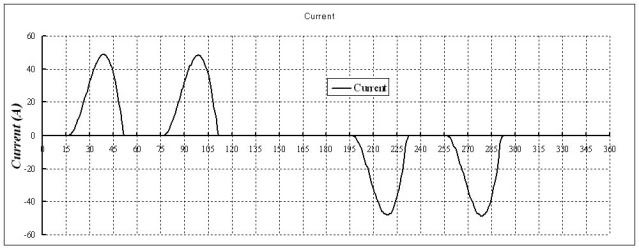What if it is not usual?Which is usuallyinsignificant.
The drive/motor manufacturer, as weressl noted, have necessary software to recommend the VFD output cable in all cases. Let the OP refer to them for his problem.
What if it is not usual?Which is usuallyinsignificant.
... There is a TCI dv/dt filer in the motor circuit as well.
Then it would be unusual.What if it is not usual?
Assume 6 pulse drive
pu current FFT (typical and for calculation reference only) ABB VFD
freq/harm...pu
f 0.6
5 0.20
7 0.14
11 0.09
13 0.07
17 0.06
19 0.05
That is lame. The VFD output has harmonics with 5th and 7th predominant. If you do not agree, please show with your own meaurement from field.Not going to happen.
Done a lot of work on drives have you?That is lame. The VFD output has harmonics with 5th and 7th predominant. If you do not agree, please show with your own meaurement from field.
Thank you once again for your kind, informative, and erudite response.That is lame. The VFD output has harmonics with 5th and 7th predominant. If you do not agree, please show with your own meaurement from field.

Assume 6 pulse drive
pu current FFT (typical and for calculation reference only) ABB VFD
freq/harm...pu
f 0.6
5 0.20
7 0.14
11 0.09
13 0.07
17 0.06
19 0.05
Bes: Fourier analysis of any VFD output has harmonics with 5th and 7th harmonics predominant to be attenuated by output filter/motor inductance Why not demonstrate it with your own meaurement from field?
I have only ever dealt with one and that was probably somewhere around two or possibly even three decades ago.Those numbers are suggestive of a 'current source inverter', where the DC link between rectifier and output switches is a large DC inductor rather than a capacitor bank.
In a CSI the inductor acts to maintain constant current through the switching elements and the load. A six step CSI will have output _current_ pulses that are approximately 120 degree square pulses with huge harmonic content.
Beo can comment about how likely it would be to find a six step CSI on a low voltage 200 hp drive installed in the past couple of years. I was under the impression that they were used at higher voltages, and are an older technology.
I have only ever dealt with one and that was probably somewhere around two or possibly even three decades ago.
For drives in the MW range, we had our own design of the Static Kramer.
Incorrect.Bes: Fourier analysis of any VFD output has harmonics with 5th and 7th harmonics predominant to be attenuated by output filter/motor inductance
Don't recall seeing that.Didn't the OP current feedback picture prove it was 6 step? Maybe ya'll need to go look at that cool 6 step sine wave he posted again?
Are you saying there is no harmonics in output wave form of VFD PWM drive?Incorrect.
Of course not! But 5th and 7th refer to the input. Not the output.Are you saying there is no harmonics in output wave form of VFD PWM drive?
lolNot going to happen.
Are you saying there is no harmonics in output wave form of VFD PWM drive?
